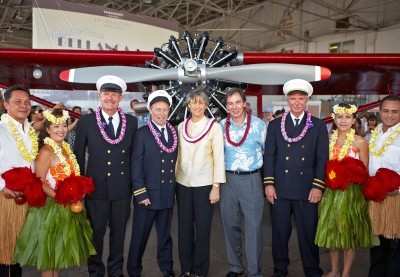A 1929 Bellanca CH-300 Pacemaker Carried The Airline's First
Passengers
 Hawaiian Airlines recently held a
special homecoming ceremony to welcome back the actual airplane
that started it all for the company 80 years ago - a 1929 Bellanca
CH-300 Pacemaker.
Hawaiian Airlines recently held a
special homecoming ceremony to welcome back the actual airplane
that started it all for the company 80 years ago - a 1929 Bellanca
CH-300 Pacemaker.
The event Thursday featured congratulatory remarks from Hawaii
Governor Linda Lingle, a traditional Hawaiian blessing by Kahu
Richard Kamanu, a hula performance, music by the Royal Hawaiian
Band, and pilots and mechanics dressed in 1929-period uniforms.
Among the attendees were family members of company founder Stanley
C. Kennedy, Sr. and sponsors and volunteers involved with bringing
this rare artifact of Hawaii aviation history back to life.
Mark Dunkerley, Hawaiian's president and CEO, commented, "For
everyone who has ever worked for Hawaiian, the Bellanca is our
ancestry and the history of pioneering aviation is in our DNA. It's
part of what makes Hawaiian special, and a big reason why we are
celebrating our 80th anniversary this year, a milestone that many
of the world's iconic airlines never reached."
Governor Lingle congratulated Hawaiian for its 80 years of
service to Hawaii. "I'm honored to be part of this historical
occasion welcoming back to Hawaii the Bellanca airplane that began
the legacy of Hawaiian Airlines. The outstanding service that
Hawaiian and its employees provide has not only made the company
vital to our state's transportation system and Hawaii's economy,
but has also established Hawaiian as a recognized leader in the
airline industry."
Earlier this year, Hawaiian acquired the Bellanca, which had
been grounded since 2000, from an aviation enthusiast in Oregon and
initiated an ambitious restoration project at Port Townsend Aero
Museum in Washington to return the plane to flying condition for
the company's 80th anniversary on November 11. Support for the
restoration was provided by many volunteers both from within and
outside the company, and by sponsors Pratt & Whitney,
manufacturer of the plane's vintage engine, International Lease
Finance Corporation, and Global Aerospace Services.
Beautifully restored, the 80-year-old airplane now holds the
distinction of being the only remaining Bellanca Pacemaker in the
world that still flies.

The Bellanca's history with the company was relatively brief,
but its impact was overwhelmingly important to the success of
Inter-Island Airways, renamed as Hawaiian Airlines in 1941. In
effect, the Bellanca helped get Hawaii's people used to the idea of
traveling between the islands by air.
Company founder Stanley C. Kennedy acquired the Bellanca in
September 1929 from the factory in Newcastle, Delaware. Kennedy
believed people in Hawaii would more readily accept the
revolutionary concept of air travel between the islands if they
could see and experience the wonders of flight above Honolulu. To
prove his faith in flying, he and family members flew on the newly
purchased Bellanca from Delaware to San Francisco - a trip that
took 28 hours flying time - from where it was shipped to
Honolulu.
On October 6, 1929, Kennedy began offering sightseeing tours
over Honolulu to great fanfare. Piloted by Captain Sam Elliott, the
company's first pilot, the Bellanca carried 76 passengers that
first day with an additional 5,000 people coming to John Rodgers
Field to watch the flights.
Kennedy's marketing strategy worked. On November 11, 1929, the
company launched scheduled air service using two Sikorsky S-38
amphibian planes that carried eight passengers and two crewmembers,
and had a top cruising speed of 110 MPH. The inaugural flight from
Honolulu to Hilo, with a stop on Maui, took more than three hours.
The first flight to Kauai was made the next day and all the islands
were soon receiving air service on a regular basis. The company has
been serving Hawaii continuously ever since.
The Bellanca was never used for interisland flights. Over the
next two years, 1930-31, the company continued to use the Bellanca
for Honolulu sightseeing tours to help promote air travel, carrying
more than 12,000 people total at a cost of $3 per person.
By 1933, the Bellanca was rarely being used and, having served
its intended purpose, was sold. The airplane was soon relocated to
Alaska where it had a long career shipping cargo and delivering
supplies to hunters and remote villages. In 1964, the plane was
moved to Oregon where it remained before being acquired by Hawaiian
for its return home to Hawaii.
 ANN's Daily Aero-Linx (05.02.24)
ANN's Daily Aero-Linx (05.02.24) ANN's Daily Aero-Term (05.02.24): Touchdown Zone Lighting
ANN's Daily Aero-Term (05.02.24): Touchdown Zone Lighting Aero-News: Quote of the Day (05.02.24)
Aero-News: Quote of the Day (05.02.24) ANN FAQ: Contributing To Aero-TV
ANN FAQ: Contributing To Aero-TV NTSB Final Report: Cirrus Design Corp SR20
NTSB Final Report: Cirrus Design Corp SR20




